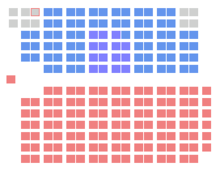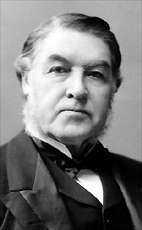Canadian federal election, 1896
| | |||||||||||||||||||||||||||||||||||||||||||||||
| |||||||||||||||||||||||||||||||||||||||||||||||
| |||||||||||||||||||||||||||||||||||||||||||||||
|
| |||||||||||||||||||||||||||||||||||||||||||||||
| |||||||||||||||||||||||||||||||||||||||||||||||
The Canadian federal election of 1896 was held on June 23, 1896 to elect members of the Canadian House of Commons of the 8th Parliament of Canada. Though the Conservative Party won a plurality of the popular vote, the Liberal Party, led by Wilfrid Laurier, won the majority of seats to form the next government.
The governing Conservative Party, since the death of John A. Macdonald in 1891, had been disorganized, going through four leaders in five years. The party was also viewed as corrupt and wasteful of public funds. Issues like the Manitoba Schools Question had cost the party support in both French and English Canada. Entering the election, the Tories were led by Sir Charles Tupper, a Father of Confederation and former Premier of Nova Scotia. Earlier, in February 1896, Tupper introduced remedial legislation to settle the Manitoba dispute, but it was filibustered by an alliance of extreme Protestants led by Dalton McCarthy and the Liberal Party. This filibuster resulted in Tupper abandoning the bill and asking for a dissolution. Parliament was dissolved on April 24, 1896, and, as per the agreement that Tupper would become Prime Minister following the election call, he became prime minister on May 1, 1896, thus forming the 7th Canadian Ministry.
Tupper argued that the real issue of the election was the future of Canadian industry, and insisted that Conservatives needed to unite to defeat the Patrons of Industry. However, the Conservatives were so bitterly divided over the Manitoba Schools Question that wherever he spoke, he was faced with a barrage of criticism, most notably at a two-hour address he gave at Massey Hall in Toronto, which was constantly interrupted by the crowd.
The election saw a great change in the Liberal Party. While the Liberals had traditionally been the party for radical change and free trade, in the 1896 election, they embraced a much more conservative platform. Because of this, many of the traditional supporters of the Conservative Party moved to the Liberals. The most important change was Laurier's support of the National Policy, an important cause to the powerful business interests of Montreal and Toronto. The Liberal campaign was directed by an ex-Tory, J. Israel Tarte. Laurier was also a strong supporter of provincial rights, and a number of powerful Liberal premiers supported the campaign such as Ontario's Oliver Mowat and Nova Scotia's W.S. Fielding, both of whom who won seats in the House and were appointed to cabinet after the election.
Ending up, the Conservatives won the most votes in the 1896 election (46.5% of the votes, in comparison to 45% for the Liberals). However, they captured only about half of the seats in English Canada, while Laurier's Liberals won a landslide victory in Quebec, where Tupper's reputation as an ardent imperialist was a major handicap. Tupper's inability to persuade Joseph-Adolphe Chapleau to return to active politics as his Quebec lieutenant ended any chances of the Conservatives' in that province.
Although Laurier had clearly won the election on June 24, Tupper initially refused to cede power, insisting that Laurier would be unable to form a government despite the Liberal Party having won 55% of the seats in the House of Commons. However, when Tupper attempted to make appointments as prime minister, Governor General Lord Aberdeen intervened, dismissing Tupper and inviting Laurier to form a government. Tupper maintained that Lord Aberdeen's actions were unconstitutional. Voter turn-out: 62.9%
National results

| ↓ | ||||
| 117 | 86 | 10 | ||
| Liberal | Conservative | O | ||
| Party | Party leader | # of candidates |
Seats | Popular vote | |||||
|---|---|---|---|---|---|---|---|---|---|
| 1891 | Elected | Change | # | % | Change | ||||
| Liberal | Wilfrid Laurier | 190 | 90 | 117 | +30.0% | 401,425 | 41.37% | -3.85pp | |
| Conservative | Charles Tupper | 190 | 97 | 71 | -16.9% | 430,874 | 44.40% | +1.44pp | |
| Liberal-Conservative | 17 | 20 | 15 | -25% | 36,541 | 3.77% | -1.85pp | ||
| Nationalist | 5 | 1 | - | -100% | 14,121 | 1.46% | +1.46pp | ||
| Independent Conservative | 4 | 3 | 4 | +33.3% | 12,209 | 1.26% | -0.68pp | ||
| Patrons of Industry | 31 | * | 2 | * | 38,275 | 3.94% | * | ||
| McCarthyite | Dalton McCarthy | 11 | * | 2 | * | 12,861 | 1.33% | * | |
| Independent | 18 | 2 | 1 | -50% | 13,870 | 1.43% | +0.61pp | ||
| Independent Liberal | 1 | 1 | 1 | - | 2,353 | 0.24% | -0.48pp | ||
| Nationalist Conservative | - | 1 | - | -100% | - | - | - | ||
| Protestant Protective | 5 | * | - | * | 6,233 | 0.64% | * | ||
| Unknown | 1 | - | - | - | 1,622 | 0.17% | -2.01pp | ||
| Total | 473 | 215 | 213 | +7.0% | 970,384 | 100% | |||
| Sources: http://www.elections.ca -- History of Federal Ridings since 1867 | |||||||||
Note:
* Party did not nominate candidates in the previous election.
Acclamations:
The following Members of Parliament were elected by acclamation;
- Ontario: 1 Patron of Industry
- Quebec: 1 Conservative, 2 Liberals
Results by province
| Party name | BC | NW | MB | ON | QC | NB | NS | PE | Total | ||
|---|---|---|---|---|---|---|---|---|---|---|---|
| Liberal | Seats: | 4 | 3 | 2 | 43 | 49 | 4 | 10 | 2 | 117 | |
| Popular vote (%): | 51.2 | 46.0 | 31.0 | 40.5 | 53.8 | 42.5 | 31.9 | 51.0 | 41.4 | ||
| Conservative | Seats: | 2 | 1 | 3 | 34 | 16 | 4 | 9 | 2 | 71 | |
| Vote (%): | 48.8 | 43.9 | 45.1 | 40.9 | 45.2 | 31.5 | 65.4 | 40.5 | 44.4 | ||
| Liberal-Conservative | Seats: | 1 | 7 | - | 5 | 1 | 1 | 15 | |||
| Vote (%): | 8.0 | 4.0 | 0.4 | 17.5 | 2.2 | 8.5 | 2.2 | ||||
| Nationalist | Seats: | - | - | - | |||||||
| Vote (%): | 3.2 | 0.5 | 1.5 | ||||||||
| Independent Conservative | Seats: | 4 | 4 | ||||||||
| Vote (%): | 3.0 | 1.3 | |||||||||
| Patrons of Industry | Seats: | 2 | 2 | ||||||||
| Vote (%): | 7.6 | 8.3 | 0.7 | 3.9 | |||||||
| McCarthyite | Seats: | 1 | 1 | 2 | |||||||
| Vote (%): | 8.3 | 2.4 | 1.3 | ||||||||
| Independent | Seats: | - | - | 1 | - | 1 | |||||
| Vote (%): | 10.0 | 1.4 | 8.6 | 0.5 | 1.4 | ||||||
| Independent Liberal | Seats: | 1 | 1 | ||||||||
| Vote (%): | 0.6 | 0.2 | |||||||||
| Total seats | 6 | 4 | 7 | 92 | 65 | 14 | 20 | 5 | 213 | ||
| Parties that won no seats: | |||||||||||
| Protestant Protective | Vote (%): | 1.5 | 0.6 | ||||||||
| Unknown | Vote (%): | 0.4 | 0.2 | ||||||||
Vote and seat summaries
Further reading
- Argyle, Ray. Turning Points: The Campaigns That Changed Canada - 2011 and Before (2011) excerpt and text search ch 4
- Blake, Donald E. "1896 and All That: Critical Elections in Canada," Canadian Journal of Political Science, June 1979, Vol. 12 Issue 2, pp 259–80
- Crunican, Paul. Priests and Politicians: Manitoba Schools and the Election of 1896 (1975)
See also
- List of Canadian federal general elections
- List of political parties in Canada
- 8th Canadian Parliament


